Earliest evidence of use of fire in Eurasia discovered in Hebrew University Excavations at Benot Ya’aqov

Excavations at the Benot Ya’aqov site in Israel
The first solid evidence of human use of fire in Eurasia as early as 790,000 years ago has been found in excavations in Israel conducted by the Hebrew University of Jerusalem Institute of Archaeology.
The discovery was made in excavations, which have been conducted over seven seasons, at the Benot Ya’aqov bridge site along the Dead Sea rift in the Hula Valley of northern Israel. According to Prof. Naama Goren-Inbar, head of the Institute of Archaeology and director of the Benot Ya’aqov excavations, this is the best evidence yet found for human use of fire during the period of the Acheulian culture (from approximately 1.8 million years to 250,000 years ago).
An article on the discovery of this early use of fire appears in the current issue of the journal Science. The article details findings of burned fragments of flint, wood, fruit and grains, indicating that the early humans living at Benot Ya’aqov knew how to control fire and use it to process food. Additional concentrations of burned flint were also found in distinct areas of the site, suggesting that the inhabitants made hearths for cooking and possibly as a site for gatherings.
Prof. Goren-Inbar says that while earlier evidence of use of fire was found in Africa, the current findings from Benot Ya’aqov are definitely the earliest yet found for Eurasia and of a more definitive quality than some of the reported evidence from Africa. The waterlogged environment of Benot Ya’aqov has provided a unique site for preservation of prehistoric archaeological finds, she points out.
The manipulation of fire by early man was clearly a turning point for our ancient ancestors, says Prof. Goren-Inbar. Once “domesticated,” fire enabled protection from predators and provided warmth and light as well as enabling the exploitation of a new range of foods.
The evidence of use of fire has been unearthed in various layers of human occupation at the Benot Ya’aqov site, illustrating that once acquired, the ability to use fire remained with generations of early humans who occupied the area over the millennia.
Media Contact
More Information:
http://www.huji.ac.ilAll latest news from the category: Earth Sciences
Earth Sciences (also referred to as Geosciences), which deals with basic issues surrounding our planet, plays a vital role in the area of energy and raw materials supply.
Earth Sciences comprises subjects such as geology, geography, geological informatics, paleontology, mineralogy, petrography, crystallography, geophysics, geodesy, glaciology, cartography, photogrammetry, meteorology and seismology, early-warning systems, earthquake research and polar research.
Newest articles

NASA: Mystery of life’s handedness deepens
The mystery of why life uses molecules with specific orientations has deepened with a NASA-funded discovery that RNA — a key molecule thought to have potentially held the instructions for…

What are the effects of historic lithium mining on water quality?
Study reveals low levels of common contaminants but high levels of other elements in waters associated with an abandoned lithium mine. Lithium ore and mining waste from a historic lithium…

Quantum-inspired design boosts efficiency of heat-to-electricity conversion
Rice engineers take unconventional route to improving thermophotovoltaic systems. Researchers at Rice University have found a new way to improve a key element of thermophotovoltaic (TPV) systems, which convert heat…



